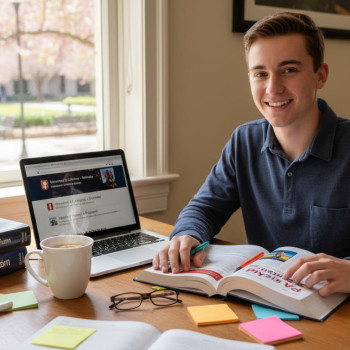Why Question-Only Socratic Study Groups Work for AP Students
If you’ve ever sat through a study group where everyone quietly swaps notes or silently annotates the same review packet, you know that not all group study is created equal. Question-only Socratic sessions flip the script. Instead of answering right away or lecturing, students ask incisive questions that probe assumptions, clarify reasoning, and reveal gaps in understanding. That gentle pressure to think aloud and defend ideas mirrors what AP exams demand — clear reasoning, evidence-based explanations, and the ability to synthesize multiple perspectives.

The science behind asking better questions
Neuroscience and educational psychology both show that retrieval practice (trying to recall or generate answers) and elaboration (explaining and connecting ideas) are among the most effective learning strategies. Socratic, question-only sessions combine the two: when a peer poses a question you must retrieve knowledge and then elaborate verbally, which strengthens memory pathways and deepens conceptual understanding. For AP students, who must apply content knowledge to novel prompts (especially in AP Seminar, AP History, AP Biology, and AP Literature), practicing how to think, not just what to memorize, is essential.
How to Run a Question-Only Socratic Session: The Blueprint
Here’s a practical, repeatable structure you can use with your classmates — whether you’re prepping for AP Calculus, AP U.S. History, AP Chemistry, or any other exam.
- Group size: 4–8 students. Small enough for everyone to speak, large enough for varied perspectives.
- Duration: 45–75 minutes. Keep energy high; longer sessions work only with breaks and clear roles.
- Materials: One question deck per person (index cards, Google Doc, or AP Classroom prompts). A visible timer and a simple rules sheet.
- Roles: Facilitator (rotates), Timekeeper, Recorder (notes unanswered questions), and Participant(s).
Session rules — keep it Socratic
- No immediate answers. Respond with a clarifying or probing question instead.
- Everyone must ask at least two questions per round.
- Use evidence language: “What evidence supports that?”, “How does that connect to…?”, “Why might that assumption fail?”
- When a question stumps the group, tag it for research and follow-up in the next session.
Sample Session Plan: 60 Minutes
Below is a tight agenda designed for busy AP students.
| Time | Activity | Purpose |
|---|---|---|
| 0–5 min | Warm-up question (everyone answers a rapid-fire question) | Activate prior knowledge and get voices flowing |
| 5–30 min | Round 1: Each member poses one content question (no answers) | Probe core concepts and uncover misunderstandings |
| 30–45 min | Round 2: Application questions or AP-style prompts | Practice transfer and exam-style thinking |
| 45–55 min | Deep-dive on 1–2 stumper questions (group researches briefly or reasons through) | Model problem-solving and build collaborative research habits |
| 55–60 min | Wrap-up: Each person writes one follow-up question for next session | Maintain momentum and accountability |
Timing tips
Use the Pomodoro method for long sessions: 25 minutes of intense question rounds, 5–10 minute break, and then another focused round. This keeps cognitive load manageable and energy high. The facilitator should keep the pace brisk while allowing deep dives when a complex, exam-like question appears.
Question Types That Drive AP-Level Thinking
Not all questions are equal. For AP success, orient questions toward analysis, synthesis, and evaluation. Here are categories that reliably push you beyond recall:
- Clarifying questions: “What does the author mean by X?” or “In this reaction mechanism, why is step two rate-limiting?”
- Connection questions: “How does this concept link to what we learned in Unit 2?”
- Application questions: “Given this graph, what would happen if the temperature increased?”
- Counterfactuals: “If event A had not occurred, how might the outcome differ?”
- Evidence-based challenges: “What specific data supports this claim?”
- Exam-practice prompts: Turn one of the questions into a 5-minute FRQ-style oral answer.
Examples by subject
Here are sample question-only prompts tailored for different AP courses. Use them as templates to make your own.
- AP Biology: “What mechanism explains why species X is better adapted to environment Y?”
- AP Calculus: “How does the mean value theorem guarantee a root for the derivative in this interval?”
- AP U.S. History: “Which economic factor most influenced the political realignment of the 1930s, and why?”
- AP Chemistry: “Given this titration curve, what is the equivalence point and how would a weak acid change the graph?”
- AP English Language: “What rhetorical strategy does the writer use to build credibility, and how does it affect the audience?”
How to Craft High-Quality Question Cards
Make question cards short, layered, and modular so they can scale in difficulty. Each card should have a primary question and two follow-ups that deepen the inquiry. That way, a single prompt can turn into a 10-minute exchange that mimics the complexity of AP prompts.
- Front: One clear question (e.g., “Why did the Progressive Era lead to new regulatory policies?”).
- Back: Two probes (“Which social groups benefited most and why?”, “How might a political scientist dispute this view?”).
Quality checklist for a strong question
- Requires analysis or explanation, not just definition.
- Connects to course themes or AP skills (evidence, synthesis, calculation).
- Is open-ended enough to allow multiple valid perspectives.
Grading the Practice: Using Sessions to Boost Exam Scores
Question-only sessions are not just warm, fuzzy conversations — they should map directly to AP scoring rubrics. Turn one or two rounds each week into explicit exam practice: pick an AP free-response prompt, and have one student pose it as a question while others interrogate the reasoning behind a model answer. The recorder can map the group’s explanations to rubric points.
| Practice Activity | Mapped Skill | AP Exam Benefit |
|---|---|---|
| Debate a claim using evidence cards | Evidence selection and citation | Stronger argumentation in FRQs and essays |
| Ask file-card calculation questions aloud | Stepwise problem solving | Quicker, more accurate solutions on multiple-choice and free response |
| Turn a complex question into a 5-minute oral rubric alignment | Formatting answers to match AP rubrics | Higher exam scoring consistency |
Common Challenges and How to Overcome Them
Every group hits friction — awkward pauses, dominant voices, or questions that go nowhere. Here are practical fixes:
- Dominant speakers: Enforce a speaking order and give quiet members an explicit invitation to ask or reframe a question.
- Running out of questions: Use AP Classroom topic questions, past free-response prompts, or Sparkl’s tailored study plan suggestions to generate material.
- Off-topic tangents: The facilitator gently refocuses with a clarifying question: “How does that relate to our prompt?”
- Surface-level questions: Use a ‘‘three-layer test’’ — can this question be followed by two deeper probes? If not, rework it.
Integrating Technology Without Killing the Energy
Technology can amplify question-only sessions if used sparingly. Shared Google Docs or a collaborative notes app can store question decks, keep a running list of stumper questions, and archive model answers mapped to rubrics. Use a shared timer app to maintain pace. If your group uses tools like Sparkl’s online tutoring — particularly their 1-on-1 guidance and AI-driven insights — consider scheduling follow-up one-on-one sessions for tricky topics uncovered during group time. Those targeted sessions help students convert group discovery into individualized mastery.
Dos and don’ts for tech use
- Do: Use a shared doc for question decks and a photo of charts or problem setups when necessary.
- Don’t: Let screens replace face-to-face questioning; the verbal friction is the learning gold.
Measuring Progress: Simple Metrics for Real Growth
Track progress so sessions stay purposeful. Here are three lightweight metrics you can use weekly:
- Question quality score: Each student rates the depth of questions they received (1–5). Average it for trends.
- Rubric alignment count: How many rubric points did your group’s explanations hit for each weekly FRQ?
- Stumper follow-ups: Number of unresolved questions researched and resolved by the next meeting.
These measures give both qualitative and quantitative feedback: you’ll see whether questions are getting sharper, whether your answers map better to AP expectations, and whether the group is closing knowledge gaps.
Real-World Examples: What A Week of Socratic Prep Looks Like
Imagine a group of six students preparing for AP U.S. History and AP Biology simultaneously. Monday’s short online session (30 minutes) is purely question-only: four clarifying and two connection questions per person. Wednesday’s 60-minute in-person meeting includes an AP-style FRQ round. Saturday, pairs take two stumper questions to Sparkl’s tutors for targeted 1-on-1 feedback. By Sunday evening, students update their shared question deck with refined probes and evidence citations.
Over a month, this rhythm builds three things: sharper questioning, collaborative research habits, and individualized remediation when a topic proves stubborn. The combination of group Socratic practice and occasional personalized tutoring (like Sparkl’s expert tutors and AI-driven insights) accelerates mastery more than solo cramming.
Tips for Leaders: How to Facilitate without Lecturing
- Ask the question you want answered: If the group stalls, the facilitator should pose a guiding question that nudges thinking rather than supplying solutions.
- Model the Socratic response: Use follow-up questions that require evidence or a chain of reasoning.
- Rotate roles weekly: Let shy students lead as facilitators in low-pressure sessions to build confidence.
- Keep a running ‘stumper’ list: Review at the start of every session so the group knows progress is being tracked.
Sample Question Deck: 20 Start-to-Finish Prompts
Below are cross-disciplinary prompts you can adapt. Each is intentionally open-ended to invite evidence-based discussion and AP-style analysis.
- What underlying assumption drives the primary claim in this passage or theory?
- How would you test this hypothesis with an experiment or data set?
- What counterexample challenges this generalization, and what does that tell us?
- How does this development connect to a larger historical or scientific trend?
- If you were grading an AP essay on this topic, what evidence would earn full points?
- Which variables matter most in this scenario, and why?
- How might cultural context change the interpretation of this source?
- What is the most convincing alternative explanation to this claim?
- What assumptions would you need to verify to feel confident about this conclusion?
- How can this concept be represented in a graph or model for clearer analysis?
Putting It All Together: A 6-Week Roadmap to AP Readiness
Transforming sessions into measurable gains takes planning. Here’s a compact roadmap you can follow in the six weeks before your AP exam window.
| Weeks | Focus | Group Activities | Individual Follow-Up |
|---|---|---|---|
| Weeks 1–2 | Foundations and question craft | Practice clarifying and connection questions; build deck | Short concept-recall self-tests and Sparkl-led diagnostic if available |
| Weeks 3–4 | Application and rubric mapping | Turn group questions into FRQ practice and rubric alignment | One-on-one sessions to address persistent weak points |
| Weeks 5–6 | Refinement and stamina | Timed oral FRQs and rapid-fire question rounds | Final targeted tutoring sessions and exam logistics review |
Why Mixing Group Inquiry with Personalized Tutoring Works
Group sessions excel at exposing misconceptions and building collaborative reasoning, but they can’t always dive deep into every individual’s gaps. That’s where personalized tutoring complements the Socratic approach: after question-only sessions reveal patterns of weakness, a short 1-on-1 with an expert tutor can convert those communal discoveries into individualized skill-building. For teams using Sparkl’s tutoring, the AI-driven insights and tailored study plans help zero in on precisely what to practice between groups — making your study time far more efficient.
Final Notes: Make It Human, Make It Habit
Socratic question-only groups are not a magic bullet, but they are the most human form of deliberate practice you can choose. They force you to speak, to test your assumptions, and to learn how to reason under gentle pressure — all skills that AP exams reward. Start small, keep it social, and use targeted tutoring when the group uncovers a stubborn plateau. Over time, the habit of asking deeper questions will not only boost your AP scores but also reshape how you learn in college and beyond.

Ready to run your first session?
Grab a handful of friends, pick an AP topic, and set a 45-minute timer. Start with clarifying questions, challenge each other to go deeper, and record the top three stumper questions to tackle with follow-up study or a short personalized tutoring session. You’ll be surprised how quickly a question-only routine turns shaky recall into confident, exam-ready thinking.
Good luck — and remember: the right question asked at the right time is the spark that turns confusion into clarity.


















No Comments
Leave a comment Cancel